Abstract
Measuring evapotranspiration (ET) components in cotton fields under mulched drip irrigation is needed to improve water use efficiency and promote the development of water-saving agriculture. In this study, an Eddy Covariance (EC) system was used to observe the water-carbon fluxes of cotton fields under mulched drip irrigation in an arid region during two years (2021–2022). The Underlying Water Use Efficiency (uWUE) method was used to partition the ET into transpiration (T) and evaporation (E) in order to reveal the changing characteristics of ET and its components in cotton fields under mulched drip irrigation and analyze the effects of environmental factors on each component. The results showed that the diurnal variation of ET was the same as gross primary productivity (GPP), and their course of change showed a bimodal curve at budding, blooming, and boll stages. The relationship of T at different growth stages was the same as ET, which is blooming and boll stage > budding stage > boll opening stage > seedling stage. ET and its components were mainly affected by temperature (Tair) and net radiation (Rn). This study can provide a theoretical and practical basis for the application of uWUE in cotton fields under mulched drip irrigation and a scientific basis for the rational allocation of water resources and the formulation of a scientific water-saving irrigation system for farmland in an arid region.
1. Introduction
Evapotranspiration (ET) is an important component of the Soil-Plant-Atmosphere Continuum (SPAC). It is also a link between the land surface water cycle and the biochemical cycle [1,2,3] and an important link between the land surface water cycle and the energy cycle [4]. For farmland ecosystems, most agricultural water is consumed in the form of ET [5]. The ET of farmland consists of transpiration (T) and evaporation (E); T is closely related to crop growth, but E is ineffective evaporation. Especially in an arid region, more than 90% of precipitation returns to the atmosphere through ET [6,7]. Therefore, accurate estimation of ET components from farmland in an arid region is necessary for improving agricultural water use efficiency and promoting the development of water-saving agriculture.
At present, the partition methods for ET of farmland mainly focus on Stable Isotope Method, Direct Observation Method, and Model Method [8,9,10,11]. The instrument and equipment of Stable Isotope Method are expensive, the experiment is complex, and the workload is too large, so ordinary laboratories cannot use it for analysis [12], and this method is not suitable for agricultural and forest ecosystems when E is small [13]. The Direct Observation Method needs the Eddy Covariance (EC) system, the lysimeter, and the liquid-flow meter at the same time to determine the ET components directly, but the lysimeter cannot measure ET during irrigation and rainfall [14], and the liquid-flow meter cannot monitor the plants at the seedling stage [15], so the Direct Observation Method cannot partition the ET components continuously and completely. The accuracy of the Model Method depends on the number of parameters and the size of the experimental scale [16,17]. If the observed parameters are less or the experimental scale is not appropriate, the calculation results of the Model Method will also have a large deviation.
With the rapid development and extensive application of the EC system in farmland ET, rich research experience has been accumulated. Many scholars partitioned the ET components of different farmland systems from the perspective of water-carbon flux coupling with the help of EC system. Zhou et al. [18,19] in 2014 showed that ET was related to Gross Primary Productivity (GPP) and Vapor Pressure Deficit (VPD), proposed the concept of an underlying water use efficiency (uWUE), and argued that the relationship between GPP·VPD0.5 and ET was nearly linear when E was small and T took up a large portion of ET during the growing period. The effect of E on the relationship between GPP·VPD0.5 and ET resulted in variations in uWUE both at half-hourly and daily time scales. Since the variation in uWUE was attributed to the changes in T/ET, uWUE could be used for ET partitioning when the variations in uWUE are related to the relative portion of ET as T. Because uWUE was obtained by combining the direct effect of vapor pressure deficit (VPD) on transpiration and the response of stomatal conductance to VPD. Therefore, it was recognized as a more representative indicator of physiological regulation of water-carbon exchange than Water Use Efficiency (WUE) in plants. On this basis, Zhou et al. [20] in 2016 used uWUE to partition ET components by combining water-carbon fluxes and meteorological data, which could realize continuous estimation of T/ET at different time scales. It can be seen that using uWUE to partition ET components has the advantages of simplicity and ease of use, and ET components are in the same source area. In the same year, Berkelhammer et al. [21] estimated the T/ET of two coniferous forests in the United States using the uWUE and found that the results of the uWUE were consistent with the Stable Isotope Method. Yue Ning [22] in 2018 used the uWUE to partition the ET components of maize farmland in the semi-arid region of the Loess Plateau of China. The uWUE method could reduce the time lag of different environmental factors on a daily scale, and the accuracy of its calculation results was particularly prominent under the condition of mulching film. Ma et al. [23] in 2020 used the uWUE to simulate the ET components of the oak grassland in California, which had good applicability. Liu Bo et al. [24] in 2021 used the uWUE to partition the ET components of a paddy field in the middle and lower reaches of the Yangtze River in China, and used the Micro-Lysimeter/Eddy Covariance (ML/EC) Method to evaluate the uWUE, and found that the uWUE had a good effect on partitioning ET components in the paddy field, and the T/ET of the early rice were significantly lower than those of the late rice. Cao et al. [25] in 2022 used the Shuttleworth–Wallace Model, Priestley–Taylor Model, and uWUE to calculate T/ET, and found that the calculation results of uWUE were larger than those of other methods. Then, Rocha et al. [26] used the uWUE and the measured data of the EC system to partition the ET components of the tallgrass prairie in Kansas in the United States and found that the precipitation had a direct impact on the ET components. It can be seen that the uWUE has become an effective method for estimating T/ET. However, partitioning ET of cotton fields under mulched drip irrigation in an arid region by using the uWUE method lacks long-term observation and in-depth research, making it difficult to clarify the changes in different ET components.
The main cotton-producing area is Xinjiang in northwestern China. However, water scarcity and strong ET pose a threat to the sustainable development of cotton, resulting in instability in cotton yield and quality due to the arid climate and low precipitation in Xinjiang. Clarifying the ET components of cotton fields under mulched drip irrigation in an arid region can provide a basis for the spatial and temporal distribution of agricultural water in cotton fields. With the help of the EC system, this study carried out a two-year continuous experiment on cotton fields under mulched drip irrigation at the Key Laboratory of Modern Water-Saving Irrigation of Xinjiang Production & Construction Group. ET in cotton fields under mulched drip irrigation was partitioned into E and T by uWUE in order to clarify the law of water evapotranspiration and the impact of climate on it and scientifically understand the water cycle process of farmland for the purpose of providing scientific guidance for water-saving irrigation and achieving the goal of rational allocation of water resources.
2. Materials and Methods
2.1. Study Area
This research was carried out in 2021 and 2022 at the Key Laboratory of Modern Water-Saving Irrigation of Xinjiang Production & Construction Group, located in the oasis irrigated area in the midstream of the Manas River Basin in Xinjiang (89°59′47″ E, 44°19′28″ N), with an altitude of 412 m and a mean ground slope of 6‰. In the study area, the ground is flat, and the soil layer is deep. The soil texture is medium loam within 1 m of depth. In the 0–60 cm soil layer, the contents of available potassium (AK), alkali-hydrolyzed nitrogen (AN), available phosphorus (AP), and organic matter (OM) are 189.00, 62.01, 24.33, and 22.31 mg·kg−1, respectively. The pH is 7.42, the field capacity is 26.73%, the soil bulk density is 1.75 g·cm−3, and the groundwater depth is 10 m. The climate in the study area is a temperate continental arid climate with prominent seasonal changes in temperature, and there is a prominent temperature difference between day and night that can reach more than 20 °C. The mean annual sunshine duration is approximately 2865 h, and the mean annual precipitation and evaporation are approximately 207 mm and 1660 mm, respectively.
2.2. Cotton Cultivation Pattern and Management
The planting mode of cotton fields under mulched drip irrigation adopted the machine-harvest cotton planting mode in Xinjiang with one film, three tubes, and six rows. The film width was 205 cm. Labyrinth single-wing drip irrigation tubes were used for drip irrigation capillaries, with the spacing of drip irrigation tubes being 76 cm and the spacing of drip droppers being 30 cm. The film coverage was about 86% (ignoring the perforation on the film), as shown in Figure 1. The cotton variety was “Nongfeng 133”, and the whole process was sown manually. The spacing of cotton plants was 10 cm, and the sowing depth was 2.5 cm. Each year, cotton was sown on 1 April and harvested on 31 October. According to the growth and development of cotton, four growth stages were divided: seedling stage from 1 April to 5 May; budding stage from 26 May to 5 July; blooming and boll stage from 6 July to 30 August; and boll opening stage from 31 August to 31 October.
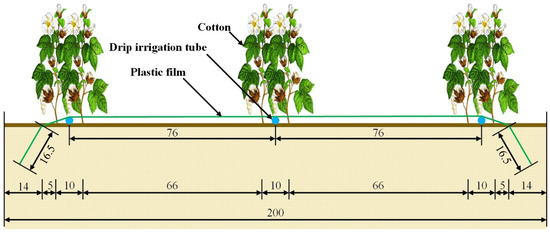
Figure 1.
Cultivation pattern of cotton fields under mulched drip irrigation (unit: cm).
For irrigation of cotton fields, the drip irrigation period was determined by the Technical Standard for Microirrigation Engineering (GB/T 50485-2020) [27], and the irrigation water quota was formulated in accordance with the Specifications for Irrigation Experiment (SL13-2015) [28]. The cotton was irrigated 14 times during the whole growth stage, and the total irrigation quota was 350 mm. The amount of drip irrigation was controlled by a high-precision water meter installed on the drip irrigation branch tube. The cotton was fertilized 10 times during the whole growth stage with 90 kg·hm−2 of nitrogen fertilizer, 60 kg·hm−2 of potassium fertilizer, and 20 kg·hm−2 of phosphate fertilizer applied each time, which was consistent with the actual production of cotton fields under mulched drip irrigation in Xinjiang.
2.3. Measurements
The EC system was used to monitor the water-carbon fluxes and ET of cotton fields under mulched drip irrigation. It consisted of a fast-response open-path infrared gas analyzer (LI-7500, LI-COR Inc., Lincoln, NE, USA), a fast-response 3D sonic anemometer (CSAT3, Campbell Inc., Logan, UT, USA), an air temperature and relative humidity sensor (HMP155, Vaisala Inc., Helsinki, Finland), a net radiometer (NR-LITE, Kipp&Zonen, Delft, Netherland), and a datalogger (CR3000, Campbell Inc., Logan, UT, USA). The installation heights of LI-7500 and CSAT3 were both 4 m above the ground. Wind speed, ultrasound virtual temperature, the densities of the atmosphere, water vapor, and CO2 were measured by them at a frequency of 10 Hz to obtain net ecosystem carbon exchange (NEE) above the canopy, and ET was determined from the latent heat flux (LE) identified by the water fluxes. The mean value of the data every 30 min was stored as a group. HMP155 was installed 4 m above the ground to measure air temperature (Tair) and relative humidity (RH). NR-LITE was installed 3 m above the ground to measure upward and downward longwave and shortwave radiation. All instruments were connected to the CR3000, which recorded and stored data every 30 min. Due to the latitude difference, the apparent solar time in the study area is 2 h later than Chinese standard time, but the crops respond to the apparent solar time. In order to facilitate comparison with other similar studies, Chinese standard time is still used in this paper.
2.4. EC System
2.4.1. Correct Fluxes Data
The flux data were processed by EddyPro Software 4.2.1(LI-COR, Lincoln, NE, USA) with Webb–Pearman–Leuning corrections and coordinate rotation corrections. Generally, The scalar gas density of the ascending gas flow is lower than that of the descending gas flow due to thermal expansion and other reasons, and the transmission of water and heat flux will affect the density of scalar gas, causing the vertical velocity change of dry air that has no effect on flux transmission. Therefore, the effect of water and heat transmission on scalar gas flux should be considered and corrected in the actual calculation [29,30,31]. The effect of density fluctuation caused by heat flux on the measurement of water vapor can be eliminated by WPL corrections to the raw high-frequency data. WPL corrections are an important correction procedure since they can correct scalar fluxes up to 50% [32]. On the other hand, the CSAT3 and LI-7500 sensors were installed within specification, i.e., 10 cm from center to center, and the cotton fields were mostly homogeneous with small spatial variability of cotton leave area index and crop height. However, because the duration of the experiment was long, it was difficult for CSAT3 to maintain absolute vertical due to the influence of gravity during long-term operation, which affected the reliability of flux observation results. Therefore, it was necessary to convert the Cartesian coordinate system of the anemometer into a streamlined coordinate system and use coordinate rotation corrections to correct the original data measured by CSAT3 [33,34]. After corrections, the data with a time interval of 30 min were finally output, including NEE, Rn, Tair, RH, vapor pressure deficit (VPD), etc.
In order to ensure the accuracy of the data, the output flux data needs to be adjusted to control the quality of the flux data because bad weather, instrument failure, power failure, and other factors will also lead to data abnormalities or even data dearth during the experiment. To ensure the integrity of the data group, it is necessary to delete the abnormal data and interpolate some missing data. The specific processes are as follows:
(1) Delete abnormal data.
Delete night data (total solar radiation < 10 W·m−2). Delete the abnormal value that obviously does not conform to the actual situation [35]. Fluxes data collected on rainy days were not used for analysis; delete them because ET cannot represent the actual situation during rainfall [36]. Delete the data when the friction wind speed (u*) is less than 0.15 m·s−1 [37].
(2) Interpolate missing data.
Different methods are used for interpolation according to the different time lengths of missing data. The linear interpolation method is used to interpolate missing data when the time length of the missing data is less than 3 h [38]. The Mean Diurnal Variation (MDV) [39] method is used to interpolate missing data when the time length of missing data is between 3 h and 24 h. If the time length of missing data is more than 24 h, the data will be regarded as invalid data without interpolation and deleted.
2.4.2. Select Typical Day
In order to understand the dynamic changes of various factors during a day, it is necessary to select a representative day from different growth stages as the typical day for specific analysis. The typical days needed to meet the following requirements are: (1) The growth status of cotton was stable and could represent the comprehensive level of its growth stage. (2) The ET process can show the typical characteristics of the stage. Because the ET process is not representative in the three days after rainfall or the three days after irrigation, these days are not considered. (3) The typical days of each reproductive stage within two years should be as close as possible.
2.4.3. Calculate GPP
NEE was partitioned into GPP and Ecosystem Respiration (Reco).
Based on the empirical index model proposed by Van’t Hoff, Lloyd and Taylor established the Lloyd and Taylor Respiratory Model [40], which provided a more accurate unbiased estimate of Reco:
where a and b are the parameters for exponential fitting of NEE and Tair, and Tair is the temperature, °C.
Because crops do not undergo photosynthesis at night, the Reco of the ecosystem at night is equal to NEE in value. In this study, the exponential function relationship between NEE and Tair at night was used to estimate the Reco of cotton at daytime [41]. The night-fitting results for two years are shown in Figure 2.
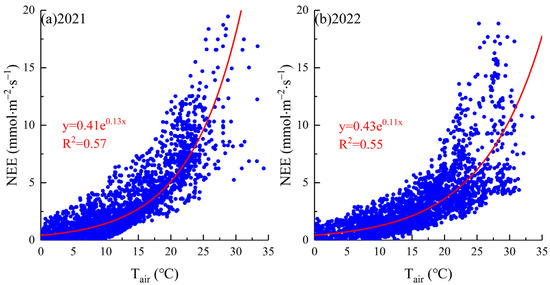
Figure 2.
The exponential fitting results of Tair and NEE in 2021 (a) and 2022 (b).
According to Monteith’s radiation efficiency theory, the missing GPP can be simulated by the nonrectangular hyperbolic model [42], and the equation is as follows:
where θ is the curvature parameter of the light response curve (0 ≤ θ ≤ 1); α is the apparent quantum efficiency; PAR is photosynthetic active radiation, μmol·m−2·s−1; Amax is the maximum net photosynthetic rate of the ecosystem, μmol·m−2·s−1.
2.4.4. Partition ET Based on Water–Carbon Flux Coupling
In this paper, the uWUE [20] was used to partition ET into different components in the study area.
The potential uWUE (uWUEp) and apparent uWUE (uWUEa) were first calculated; the equations are as follows:
The calculation equation of T/ET can be obtained as follows:
The uWUEp and uWUEa were estimated with half-hourly GPP, ET, and VPD data using the quantile regression and the linear regression methods, respectively. The quantile regression method is appropriate for estimating multiple change rates from minimum to maximum responses and can provide the regression slopes between the response and predictor variables on a series of quantiles [43]. The extreme quantiles, i.e., the 5th and 95th quantiles, were widely used to capture the lower and upper limits for the regression slopes [44,45,46]. In this study, quantile regression for the 95th percentile was used to estimate the upper bound of the ratio of GPP·VPD0.5 over ET, which is uWUEp, and its specific value can be obtained by SPSS. The linear regression technique was extensively used to develop the uWUE model and to evaluate alternative model formulations [18,19]. The least squares, unbiased estimate of the slope of the regression line was in fact a flux-weighted estimate of uWUE. In this study, the slope of the linear tropic between GPP·VPD0.5 over ET in a short time scale is uWUEa [20], and its specific value can be obtained by EXCEL. Both the quantile regression and the linear regression passed through the origin to be consistent with the condition of zero GPP when stomata were totally closed.
3. Results
3.1. Environmental Factors
ET of cotton fields under mulched drip irrigation was easily affected by Tair, RH, Rn, and VPD; the day-to-day variation of these factors was generally consistent over 2021 and 2022, as shown in Figure 3. The ranges of Tair, RH, Rn, and VPD were 2.18~32.98 °C, 18.23~69.42%, 30.08~188.98 W·m−2, and 0.07~19.54 hPa, respectively. The change trends of Tair and Rn were basically the same, both of which started increasing from the seedling stage and continued to grow until the maximum appeared at the blooming and boll stage, and then began to decline until the end of the growth stage. The annual mean values of Tair in the two years were 20.00 °C and 21.06 °C respectively, and Rn in the two years were 114.75 W·m−2 and 119.60 W·m−2, respectively. However, due to the rainy season from May to June, Rn fluctuated greatly during the budding stage. In general, RH fluctuated greatly, but the annual change had a slight upward trend. The annual mean values of RH in the two years were 48.11% and 45.29%, respectively. VPD fluctuated most strongly, with the maximum and minimum values occurring during the seeding stage and the budding stage. The annual mean values of VPD in two years were 7.14 hPa and 7.01 hPa, respectively.

Figure 3.
Day-to-day variation of environmental factors in 2021 (a) and 2022 (b).
3.2. ET and GPP
ET and GPP are important parameters for partitioning ET components and necessary intermediate variables for estimating T/ET based on the water-carbon flux coupling. Their change processes were similar throughout the whole stage, showing significant characteristics of seasonal variation, as shown in Figure 4. During the fast growth rate stage from the seedling stage to the budding stage, ET and GPP showed a significant upward trend. At the blooming and boll stages, the cotton plant morphology was basically unchanged; ET and GPP had the same daily maximum values but a large fluctuation; the daily maximum values of ET in the two years were 3.96 mm·d−1 and 4.01 mm·d−1, respectively; and the daily maximum values of GPP in the two years were 12.20 g·m−2·d−1 and 12.38 g·m−2·d−1 respectively. After the end of the blooming and boll stages, the cotton leaves began to wither, the cotton bolls swelled to internal fullness, dehydrated, and finally cracked to achieve the effect of boll opening. During the opening stage, ET and GPP gradually decreased until the end of the whole stage. Based on the results of two years of experiments, ET was 46.49 mm at seedling stage, 92.27 mm at buddling stage, 106.11 mm at blooming and boll stage, and 66.03 mm at boll opening stage. GPP at four growth stages was 165.24 g·m−2, 264.60 g·m−2, 376.54 g·m−2, and 185.12 g·m−2, respectively. The size rules of ET and GPP at four growth stages were consistent: blooming and boll stage > budding stage > boll opening stage > seedling stage.
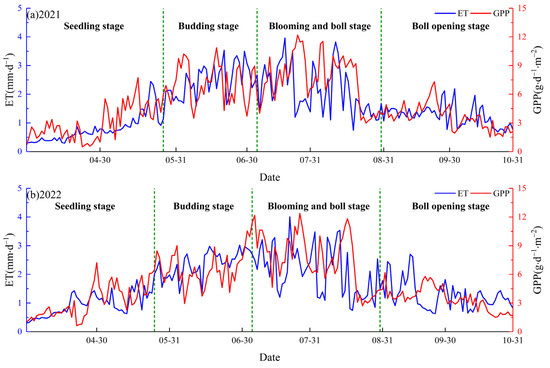
Figure 4.
Day-to-day variation of the ET and GPP in 2021 (a) and 2022 (b).
During different growth stages over two years, a certain day was selected as a typical day, and the diurnal dynamic change processes of ET and GPP were specifically analyzed by taking their mean values. Due to the fact that ET and photosynthesis mainly occur during the daytime, only the diurnal dynamic changes of ET and GPP during 08:00–22:00 were analyzed, as shown in Figure 5.
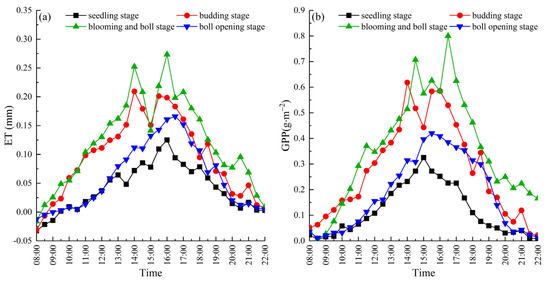
Figure 5.
Diurnal variation of the ET (a) and GPP (b).
For seedling stage, ET reached the maximum value of 0.13 mm at 16:00, and GPP reached the maximum value of 0.33 g·m−2 at 15:00. The diurnal dynamic change processes of both were unimodal curves. For the budding stage, ET reached the maximum value of 0.21 mm at 14:00–15:30, and GPP reached the maximum value of 0.62 g·m−2 at 14:00–16:00. The diurnal dynamic change processes of the two showed bimodal curves. For blooming and boll stages, ET reached the maximum value of 0.27 mm at 14:00–16:00, and GPP reached the maximum value of 0.80 g·m−2 at 14:30–16:30. The diurnal dynamic change processes of both were also bimodal curves. For the boll opening stage, ET reached the maximum value of 0.17 mm at 16:30, and GPP reached the maximum value of 0.42 g·m−2 at 15:30. The diurnal dynamic change processes of the two were unimodal curves. As shown in Figure 5, it can be seen that the daily maximum values of ET and GPP in different growth stages all occur between 14:00 and 16:30, and their size rules on typical days of different growth stages are consistent with their annual changes.
3.3. ET Components
uWUEp and uWUEa at different growth stages of cotton fields under mulched drip irrigation in 2021 and 2022 were obtained by the method mentioned in 2.4.3; the results are shown in Figure 6 and Table 1.
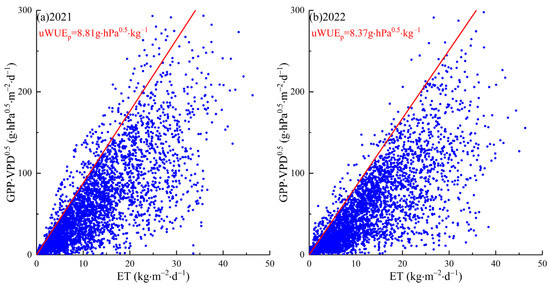
Figure 6.
Results of the uWUEp in 2021 (a) and 2022 (b).

Table 1.
The value of uWUE at different growth stages.
T/ET values at different growth stages were calculated by Equation (6). The calculation results are shown in Table 2 and the changes of the ET components are shown in Figure 7.

Table 2.
ET components of cotton fields under mulched drip irrigation at different growth stages.
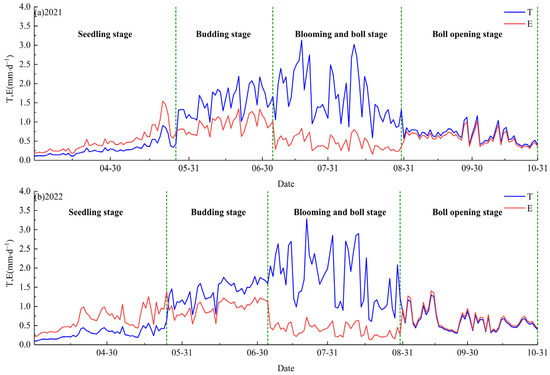
Figure 7.
E and T of cotton fields under mulched drip irrigation at different growth stages in 2021 (a) and 2022 (b).
On the whole, T showed a trend of increasing first and then decreasing, and the change curve was in the form of a single peak. On the contrary, the change process in E was in the form of double peaks. At the seedling stage, because the cotton plant was short, the number and area of leaves were small, and the canopy coverage of the soil was the lowest, T was weak at this stage. ET was mainly E, so the change curve of E was slightly higher than that of T. The values of T in 2021 and 2022 were 17.5 mm and 15.48 mm in seedling stage, respectively, accounting for 37% and 31% of ET in this growth stage. With the growth of cotton, the cotton plant became higher and higher, and the number and area of leaves and the canopy coverage of soil begun to increase. Therefore, at the budding stage and the blooming and boll stage, T became stronger and stronger, and its proportion in ET became larger and larger. ET was dominated by T, and the change curve of T was much higher than that of E. During the whole stage in two years, the values of T in the budding stage were 54.52 mm and 54.49 mm, accounting for 62% and 59%, respectively. The values of T in blooming and boll stages were 82.41 mm and 88.48 mm, accounting for 79% and 82%, respectively. After the end of blooming and the boll stage, cotton started to enter the boll opening stage. At this time, the cotton plant size did not change, but the leaves started to wither, and the cotton bolls needed to undergo dehydration before cracking, so the strengths of T and E in this stage were less different, and their change curves basically coincided. T in the boll opening stage in two years were 34.33 mm and 32.29 mm, accounting for 53% and 48% of ET, respectively. The size relationship of T/ET in different stages was: blooming and boll stage > budding stage > boll opening stage > seedling stage. This phenomenon was consistent with the size relationship of ET in different growth stages. As shown in Table 2, it can be seen that ET in cotton fields under mulched drip irrigation in an arid region is mainly T, and T is 190 mm in the whole stage, accounting for 61% of ET.
4. Discussion
4.1. uWUE Influencing Factors
In the experiment of cotton fields under mulched drip irrigation in an arid region, when CO2 concentration was high, the stomatal conductance of cotton leaves decreased, so T decreased and uWUE increased, and the two were positively correlated. However, VPD comprehensively reflected Tair and RH in the environment. When VPD was high, RH was also high, resulting in increased stomatal conductance in cotton leaves. Therefore, T was enhanced and uWUE was decreased, and the two were negatively correlated. In this study, the uWUE of cotton fields under mulched drip irrigation in an arid region was numerically equivalent to uWUEp, so the value of the uWUE was 8.59 g·hpa0.5·kg−1 through analysis in two years, while the uWUE of corn fields under mulched [22] in a semi-arid region was 12.29 g·hpa0.5·kg−1 under similar conditions. The reason was that cotton was a C3 crop and corn was a C4 crop, and the photosynthetic efficiency of C3 crops was lower than that of C4 crops.
4.2. Causes of Changes in ET and GPP
Comparing Figure 3 and Figure 4, it can be found that on an annual scale, the change process of ET and GPP is similar to the change process of Tair and Rn, with an upward trend from seedling stage to blooming and boll stage and then a downward trend until the end of the growth stage, presenting a unimodal curve overall. Hyperbola fitting was carried out between ET, GPP, and different environmental factors, as shown in Figure 8 and Figure 9, and it was found that they had the most obvious correlation with Tair and Rn. The diurnal dynamic changes of ET and GPP on a daily scale at the budding, blooming, and boll stages presented a bimodal curve. The reason is that ET is a comprehensive expression of T and E in cotton fields. At budding and blooming boll stages, cotton plants had a larger body size, a large number of leaves, and a large leaf area, while Tair, RH, Rn, and VPD were also higher. At 14:00–16:30, excessive levels of Tair and Rn would reduce the stomatal conductance of cotton leaves, resulting in a decrease in T at this time. When Tair and Rn slowly decreased, T rebounded, so the diurnal dynamic change process of ET in the two growth stages was bimodal. GPP represented the amount of CO2 that cotton fixed into organic matter through photosynthesis, similar to the cause of ET changes. Excessive levels of Tair and Rn inhibited the open-close degree of stomata on cotton leaves, resulting in weakening the absorption and utilization of CO2 by the plant, causing GPP to decrease at noon and then rise. In general, the changes of ET and GPP are synchronous on both annual and daily scales. When ET and GPP increase simultaneously, the uWUEa at each growth stage will also increase. Therefore, when ET and GPP are at their maximum, the uWUEa will also be maximum.
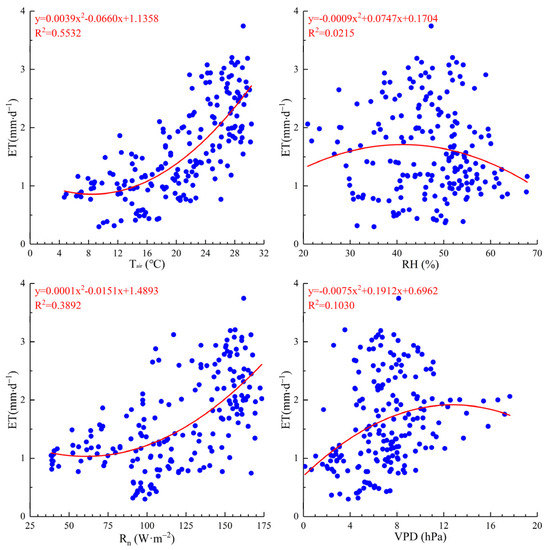
Figure 8.
Hyperbola fitting of ET and different environmental factors.
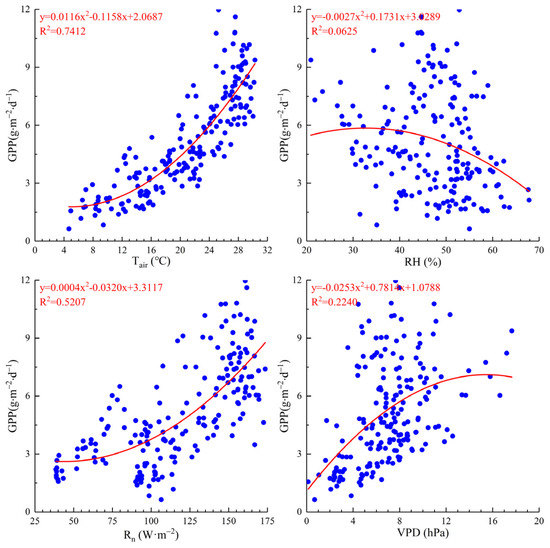
Figure 9.
Hyperbola fitting of GPP and different environmental factors.
4.3. Causes of Changes in T/ET
The T of cotton fields under mulched drip irrigation in an arid region accounted for 61% of the total ET, and its change process was also consistent with the total ET. By comparing the change processes of environmental factors and ET, T, and E, the correlation coefficient between different ET components and environmental factors is shown in Table 3. It was found that Tair and Rn were the main factors affecting T/ET.

Table 3.
Correlation coefficients between different ET components and environmental factors.
At the seedling stage, the cotton plants were short and the number and area of leaves were small, which was not conducive to T. At this stage, the Tair and Rn was low, but the RH was large, which was also not conducive to E. Because the canopy coverage of cottons on the soil were too low, E was stronger than T, more than 60% of irrigation water was lost through E. However, both T and E were small in absolute terms, and the ET was weak.
When cottons entered the budding stage, the plant began to grow rapidly, and the number and area of leaves increased to promote the enhancement of T. In this stage, Tair and Rn gradually increased, but RH decreased to promote the enhancement of E. However, the canopy coverage of cottons to the soil increased to inhibit E, so T was stronger than E and the ET was enhanced.
When cottons entered the blooming and boll stage, the plants were basically shaped, the leaves grew completely, the number and area of leaves reached the maximum value in the whole stage, and Tair and Rn also reached the maximum value in a year in this stage. However, too high Tair and Rn would inhibit the stomatal conductance of cotton leaves, so T would decrease when Tair and Rn were at their maximum. This resulted in large fluctuations in T at this stage, but compared with other stages, T in this stage was stronger than the other three stages. Although the canopy coverage of cottons to the soil was the largest in the whole stage, which inhibited E to the greatest extent, E was also the strongest in this stage due to Tair and Rn. Therefore, ET in the blooming and boll stages was the strongest in the whole stage and dominated by T. However, the T/ET of blooming and boll stage was much higher than the results under other similar conditions, which was consistent with the research results of Cao et al. [25]. The reason was that the film mulching treatment had the best effect on inhibiting ET at the blooming and boll stages. Film mulching would improve the GPP and reduce the resistance of water vapor transport from E and soil to air, so as to further improve uWUEa, which would lead to a greater value of T/ET at blooming and boll stages.
After the cottons entered the boll opening stage, the cotton plant began to age, the leaves gradually withered and lost vitality, the number and area of leaves continued to decrease, and T decreased. In this stage, the canopy coverage of cottons to soil decreased, Tair and Rn decreased, but RH increased, and E was also weakened. On the whole, the two were stronger than them at seedling stage, so the ET was weaker but stronger than seedling stage.
For the seedling stage, budding stage, blooming and boll stage, and boll opening stage, the effects of different environmental factors on T and E were basically the same, but for the whole stage, they were quite different. The reason was that the change of E in a short time scale was a single rise or a single decline, while its change process in a long time scale presented a double-peak form, and there was a mutation between the seedling stage and the budding stage, as well as between the blooming and boll stages and the boll opening stage, which was significantly different from the change process of environmental factors. Compared with the research by Wang et al. [47], E ranged from 38% to 40% of ET, and the seasonal E was high. The reason was that the drip irrigation period was short and the drip irrigation quota was large in this study; this resulted in high soil moisture content, promoting E, and reducing the effective utilization of irrigation water.
5. Conclusions
Based on the water-carbon flux coupling, uWUE was used to partition the ET of cotton fields under mulched drip irrigation in an arid region, and the effect of environmental factors on it was analyzed. The main conclusions are as follows:
(1) The changes of ET and GPP in cotton fields under mulched drip irrigation in an arid region at different time scales were consistent, which was related to the effects of Tair and Rn on stomatal conductance. The change curves at both the bud stage and the flowering and boll stage were bimodal, with a larger uWUE and a higher utilization efficiency of irrigation water;
(2) The change characteristics of T and ET of cotton fields under mulched drip irrigation in an arid region were the same, showed a continuous increasing trend from seedling stage to blooming and boll stage, reached the maximum value at blooming and boll stage, and then decreased from boll opening stage to the end of growth stage. Water use efficiency is highest in blooming and boll stage, but there is still the possibility of improving water use efficiency and reducing E during the boll opening stage;
(3) The ET components of cotton fields under mulched drip irrigation in an arid region were mainly affected by Tair and Rn, and the components of ET were positively correlated with Tair and Rn. The effective ET is the strongest when Tair and Rn are the highest and the waste of irrigation water is the least;
(4) The uWUE method of partitioning ET components doesn’t need complicated basic data and has the advantages of fewer intermediate variables and simple calculation steps.
Author Contributions
Conceptualization, Y.L. and C.Q.; Data curation, Y.L.; Formal analysis, Y.L.; Funding acquisition, C.Q.; Investigation, Y.L.; Methodology, Y.L. and C.Q.; Project administration, C.Q.; Supervision, C.Q.; Visualization, Y.L.; Writing—original draft, Y.L.; Writing—review and editing, C.Q. All authors have read and agreed to the published version of the manuscript.
Funding
This research was supported by the Key Science and Technology Project Xinjiang Production and Construction Corps of China [grant number 2022DB024]; the National Natural Science Foundation of China [grant number 51769030]; and the Key Science and Major Science and Technology Project Xinjiang Production and Construction Corps of China [grant number 2021AA003].
Data Availability Statement
Available upon request from the corresponding authors.
Acknowledgments
The authors thank all members at Key Laboratory of Modern Water-Saving Irrigation of Xinjiang Production & Construction Group for providing the experimental site and relevant supports.
Conflicts of Interest
The authors declare no conflict of interest.
References
- Ma, N.; Zhang, Y.; Guo, Y.; Gao, H.; Zhang, H.; Wang, Y. Environmental and biophysical controls on the evapotranspiration over the highest alpine steppe. J. Hydrol. 2015, 529, 980–992. [Google Scholar] [CrossRef]
- Liu, B.; Cui, Y.; Luo, Y.; Shi, Y.; Liu, M.; Liu, F. Energy partitioning and evapotranspiration over a rotated paddy field in Southern China. Agric. For. Meteorol. 2019, 276–277, 107626. [Google Scholar] [CrossRef]
- Liu, X.; Wang, G.; Yang, S.; Xu, J.; Wang, Y. Influence Factors and Characteristics of Transpiration and Evaporation in Water-saving Irrigation Paddy Field under Different Temporal Scales. Trans. Chin. Soc. Agric. Mach. 2016, 47, 91–100+170. [Google Scholar]
- Stocker Thomas, F.; Raible Christoph, C. Climate change: Water cycle shifts gear. Nature 2005, 434, 830–833. [Google Scholar] [CrossRef] [PubMed]
- Feng, Y.; Gong, D.-Z.; Wang, H.-B.; Hao, W.-P.; Mei, X.-R.; Cui, N.-B. Estimating Rainfed Maize Evapotranspiration Using the FAO Dual Crop Coefficient Method on the Loess Plateau. Chin. J. Agrometeorol. 2017, 38, 141–149. [Google Scholar]
- Liu, X.-Y.; Li, Y.-Z.; Zhong, X.-L.; Cao, J.-F.; Yuan, X.-H. Evaluation of 16 Models for Reference Crop Evapotranspiration (ET0) Based on Daily Values of Weighing Lysimeter Measurements. Chin. J. Agrometeorol. 2017, 38, 278–291. [Google Scholar]
- Zhao, W.; Ji, X.; Liu, H. Progresses in Evapotranspiration Research and Prospect in Desert Oasis Evapotranspiration Research. Arid Zone Res. 2011, 28, 463–470. [Google Scholar]
- Wu, Y.; Du, T. Estimating and partitioning evapotranspiration of maize farmland based on stable oxygen isotope. Trans. Chin. Soc. Agric. Eng. (Trans. CSAE) 2020, 36, 127–134. [Google Scholar]
- Xu, X.W.; Yu, X.X.; Jia, G.D.; Li, H.Z.; Lu, W.W.; Liu, Z.Q. A review of water and carbon flux partitioning and coupling in SPAC using stable isotope techniques. Chin. J. Appl. Ecol. 2017, 28, 2369–2378. [Google Scholar]
- Wu, Y.; Du, T. Evaporation and its influencing factors in farmland soil in the arid region of Northwest China. Trans. Chin. Soc. Agric. Eng. (Trans. CSAE) 2020, 36, 110–116. [Google Scholar]
- Rafi, Z.; Merlin, O.; Le Dantec, V.; Khabba, S.; Mordelet, P.; Er-Raki, S.; Amazirh, A.; Olivera-Guerra, L.; Hssaine, B.A.; Simonneaux, V.; et al. Partitioning evapotranspiration of a drip-irrigated wheat crop: Inter-comparing eddy covariance-, sap flow-, lysimeter- and FAO-based methods. Agric. For. Meteorol. 2019, 265, 310–326. [Google Scholar] [CrossRef]
- Griffis, T.J. Tracing the flow of carbon dioxide and water vapor between the biosphere and atmosphere: A review of optical isotope techniques and their application. Agric. For. Meteorol. 2013, 174–175, 85–109. [Google Scholar] [CrossRef]
- Gu, L.; Meyers, T.; Pallardy, S.G.; Hanson, P.J.; Yang, B.; Heuer, M.; Hosman, K.P.; Liu, Q.; Riggs, J.S.; Sluss, D.; et al. Influences of biomass heat and biochemical energy storages on the land surface fluxes and radiative temperature. J. Geophys. Res. Atmos. 2007, 112, D02107. [Google Scholar]
- Zhou, S.; Yu, B.; Zhang, Y.; Huang, Y.; Wang, G. Water use efficiency and evapotranspiration partitioning for three typical ecosystems in the Heihe River Basin, northwestern China. Agric. For. Meteorol. 2018, 253–254, 261–273. [Google Scholar] [CrossRef]
- Wilson, K.B.; Hanson, P.J.; Mulholland, P.J.; Baldocchi, D.D.; Wullschleger, S.D. A comparison of methods for determining forest evapotranspiration and its components: Sap-flow, soil water budget, eddy covariance and catchment water balance. Agric. For. Meteorol. 2001, 106, 153–168. [Google Scholar] [CrossRef]
- Shuttleworth, W.J.; Wallace, J.S. Evaporation from sparse crops-an energy combination theory. Q. J. R. Meteorol. Soc. 1985, 111, 839–855. [Google Scholar] [CrossRef]
- Kool, D.; Agam, N.; Lazarovitch, N.; Heitman, J.L.; Sauer, T.J.; Ben-Gal, A. A review of approaches for evapotranspiration partitioning. Agric. For. Meteorol. 2014, 184, 56–70. [Google Scholar] [CrossRef]
- Zhou, S.; Yu, B.; Huang, Y.; Wang, G. The effect of vapor pressure deficit on water use efficiency at the subdaily time scale. Geophys. Res. Lett. 2014, 41, 5005–5013. [Google Scholar] [CrossRef]
- Zhou, S.; Yu, B.; Huang, Y.; Wang, G. Daily underlying water use efficiency for AmeriFlux sites. J. Geophys. Res. Biogeosci. 2015, 120, 887–902. [Google Scholar] [CrossRef]
- Zhou, S.; Yu, B.; Zhang, Y.; Huang, Y.; Wang, G. Partitioning evapotranspiration based on the concept of underlying water use efficiency. Water Resour. Res. 2016, 52, 1160–1175. [Google Scholar] [CrossRef]
- Berkelhammer, M.; Noone, D.C.; Wong, T.E.; Burns, S.P.; Knowles, J.F.; Kaushik, A.; Blanken, P.D.; Williams, M.W. Convergent approaches to determine an ecosystem’s transpiration fraction. Glob. Biogeochem. Cycles 2016, 30, 933–951. [Google Scholar] [CrossRef]
- Ning, Y. Water Use Efficiency and Its Response to T/ET of Maize Field in Longzhong Semi-Arid Area. Master’s Thesis, Lanzhou University, Lanzhou, China, 2018. [Google Scholar]
- Ma, S.; Eichelmann, E.; Wolf, S.; Rey-Sanchez, C.; Baldocchi, D.D. Transpiration and evaporation in a Californian oak-grass savanna: Field measurements and partitioning model results. Agric. For. Meteorol. 2020, 295, 108–204. [Google Scholar] [CrossRef]
- Liu, B.; Wang, W.; Cui, Y.; Xu, T. Partitioning evapotranspiration using the water-carbon flux coupling in a paddy field in the Middle and Lower Reaches of the Yangtze River in China. Trans. Chin. Soc. Agric. Eng. (Trans. CSAE) 2021, 37, 94–101. [Google Scholar]
- Cao, R.; Huang, H.; Wu, G.; Han, D.; Jiang, Z.; Di, K.; Hu, Z. Spatiotemporal variations in the ratio of transpiration to evapotranspiration and its controlling factors across terrestrial biomes. Agric. For. Meteorol. 2022, 321, 108984. [Google Scholar] [CrossRef]
- Da, R.A.E.Q.; Alvarez, S.E.; Andres, P. Partitioning evapotranspiration in a tallgrass prairie using micrometeorological and water use efficiency approaches under contrasting rainfall regimes. J. Hydrol. 2022, 608, 127624. [Google Scholar]
- GB/T 50485-2020; National Standard of the People’s Republic of China: Technical Standard for Microirrigation Engineering. China Planning Press: Beijing, China, 2020.
- SL 13-2015; Standard of Ministry of Water Resources of the People’s Republic of China: Specifications for Irrigation Experiment. China Water & Power Press: Beijing, China, 2015.
- Burba, G. The Eddy Covariance Method; LI-COR Biosciences: Lincoln, NE, USA, 2013; p. 331. [Google Scholar]
- Webb, E.K.; Pearman, G.; Leuning, R. Correction of flux measurements for density effects due to heat and water vapour transfer. Q. J. R. Meteorol. Soc. 1980, 106, 85–100. [Google Scholar] [CrossRef]
- Lee, X.; Massman, W.J. A Perspective on Thirty Years of the Webb, Pearman and Leuning Density Corrections. Bound.-Layer Meteorol. 2011, 139, 37–59. [Google Scholar] [CrossRef]
- Mauder, M.; Foken, T. Impact of post-field data processing on eddy covariance flux estimates and energy balance closure. Meteorol. Z. 2006, 15, 597–609. [Google Scholar] [CrossRef]
- Hobbs, S. Atmospheric boundary layer flows: Their structure and measurement. J. Atmos. Terr. Phys. 1995, 57, 1357. [Google Scholar] [CrossRef]
- Wilczak, J.M.; Oncley, S.P.; Stage, S.A. Sonic Anemometer Tilt Correction Algorithms. Bound.-Layer Meteorol. 2001, 99, 127–150. [Google Scholar] [CrossRef]
- Wei, J.; Xu, H.; Zhou, L.; Cheng, X.; Tang, X.; Fu, Z.; Tang, Q.; Tang, J. Seasonal variation in carbon exchange and its modulating factors of a double cropping rice ecosystem in Southern China. J. Agro-Environ. Sci. 2018, 37, 1035–1044. [Google Scholar]
- Zhu, Z.; Sun, X.; Zhou, Y.; Xu, J.; Yuan, G. Correction method for eddy covariance fluxes of non-flat underlying surface and its application in ChinaFLUX. Sci. China Ser. D Earth Sci. 2004, S2, 37–45. [Google Scholar]
- Xing, Q.; Han, G.; Yu, J.B.; Wu, L.X.; Yang, L.; Mao, P.L.; Wang, G.; Xie, B. Net ecosystem CO2 exchange and its controlling factors during the growing season in an inter-tidal salt marsh in the Yellow River Estuary. Acta Ecol. Sin. 2014, 34, 4966–4979. [Google Scholar]
- Baldocchi, D.D. Assessing ecosystem carbon balance: Problems and prospects of the eddy covariance technique. Glob. Chang. Biol. 2003, 9, 478–492. [Google Scholar] [CrossRef]
- Falge, E.; Baldocchi, D.; Olson, R.; Anthoni, P.; Aubinet, M.; Bernhofer, C.; Burba, G.; Ceulemans, R.; Clement, R.; Dolman, H.; et al. Gap filling strategies for defensible annual sums of net ecosystem exchange. Agric. For. Meteorol. 2001, 107, 43–69. [Google Scholar] [CrossRef]
- Lloyd, J.; Taylor, J.A. On the Temperature Dependence of Soil Respiration. Funct. Ecol. 1994, 8, 315–323. [Google Scholar] [CrossRef]
- Guo, W.H.; Kang, S.Z.; Li, F.S.; Li, S.E. Variation of NEE and its affecting factors in a vineyard of arid region of northwest China. Atmos. Environ. 2014, 84, 349–354. [Google Scholar] [CrossRef]
- Gilmanov, T.G.; Verma, S.B.; Sims, P.L.; Meyers, T.P.; Bradford, J.A.; Burba, G.G.; Suyker, A.E. Gross primary production and light response parameters of four Southern Plains ecosystems estimated using long-term CO2-flux tower measurements. Glob. Biogeochem. Cycles 2003, 17, 1071. [Google Scholar] [CrossRef]
- Cade, B.S.; Noon, B.R. A Gentle Introduction to Quantile Regression for Ecologists. Front. Ecol. Environ. 2003, 1, 412–420. [Google Scholar] [CrossRef]
- Yu, K.; Moyeed, R.A. Bayesian quantile regression. Stat. Probab. Lett. 2001, 54, 437–447. [Google Scholar] [CrossRef]
- Bremnes, J.B. Probabilistic wind power forecasts using local quantile regression. Wind Energy 2004, 7, 47–54. [Google Scholar] [CrossRef]
- Wang, L.; Good, S.P.; Caylor, K.K. Global synthesis of vegetation control on evapotranspiration partitioning. Geophys. Res. Lett. 2014, 41, 6753–6757. [Google Scholar] [CrossRef]
- Wang, X.F.; Hu, S.J.; Tian, C.Y.; Luo, Y. The changing law of the diurnal evapotranspiration and soil evaporation in cotton field of Tarim irrigation area. Agric. Res. Arid. Areas 2012, 30, 74–78. [Google Scholar]
Disclaimer/Publisher’s Note: The statements, opinions and data contained in all publications are solely those of the individual author(s) and contributor(s) and not of MDPI and/or the editor(s). MDPI and/or the editor(s) disclaim responsibility for any injury to people or property resulting from any ideas, methods, instructions or products referred to in the content. |
© 2023 by the authors. Licensee MDPI, Basel, Switzerland. This article is an open access article distributed under the terms and conditions of the Creative Commons Attribution (CC BY) license (https://creativecommons.org/licenses/by/4.0/).